11 Companion Plants for Celery (With Pictures)
-

- Last updated:

Some plants may do well on their own, but others may need a gardening companion to thrive better as they benefit from each other. One plant that benefits a great deal from this arrangement is celery.
Celery is a delicate little vegetable. You may wonder what companion plants to use to maximize your celery yield in your garden. We have a list of 11 ideal companion plants to make your celery grow big and strong.

Allium Companion Plants for Celery
1. Leeks

| Best Soil Type: | Well-drained soil with high organic matter |
| Soil pH: | Between 6.0 and 7.0 |
| Optimum Growing Temperature: | 55°F to 75°F (12.7°C to 23.9°C) |
| Sunlight Exposure: | Full sun |
| Watering Requirements: | One inch of water every week (water until it’s established) |
Celery and Leeks¹ are an excellent combination in the vegetable garden. They prefer cool weather and heavy, well-drained soil. Besides, both plants shade each other.
Additionally, leeks safeguard the growing celery from celery leaf miners. The strong fragrance of the leeks¹ fools pests. The pests will search for other plants they can attack instead of attacking celery.
You can plant leeks in late summer to early fall when celery is starting to produce tops for harvesting. Plant them where they’ll not interfere with the growth of the celery stalks or leaves.
2. Onions
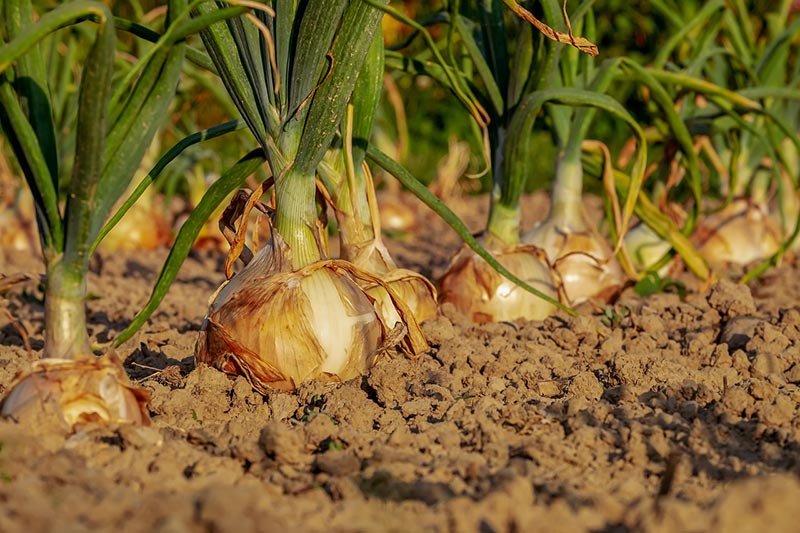
| Best Soil Type: | Well-drained, highly organic soil |
| Soil pH: | Between 6.0 and 7.0 |
| Optimum Growing Temperature: | 75°F (24°C) |
| Sunlight Exposure: | Six hours of full sun every day |
| Watering Requirements: | Water up to one inch deep once every week |
Like other alliums, Onions¹ have a strong fragrance that discourages pests from attacking celery. When planted near each other, the two plants help each other grow better and stronger than they would without the other nearby. Additionally, the onions help improve the taste of celery when they grow close together.
Plant the onions next to the celery seedlings once they’ve been transplanted into the garden. You can also plant onions in the garden before sowing your celery seeds.
Vegetable Companion Plants for Celery
3. Cabbage
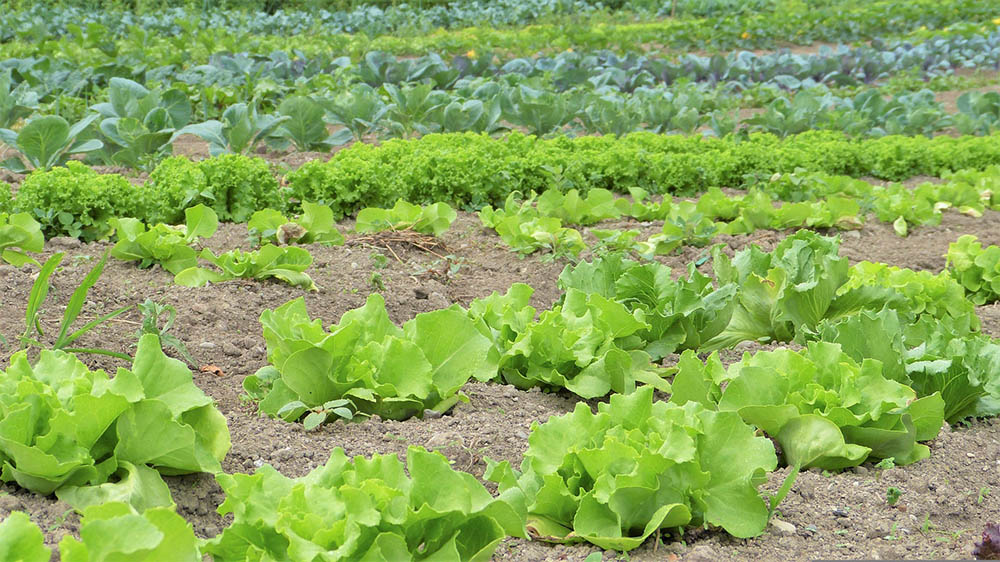
| Best Soil Type: | Well-drained, fertile soil that retains moisture |
| Soil pH: | 6 to 7 |
| Optimum Growing Temperature: | 60°F to 65°F (15°C to 18°C) |
| Sunlight Exposure: | Six hours of direct sunlight daily |
| Watering Requirements: | Ensure the soil is evenly moist but not waterlogged |
Cabbage¹ is in the brassica family. It provides shade for your young celery during hot weather. These two veggies also have a symbiotic relationship when planted together. They each benefit from the other’s presence while working together to deter pests!
Cabbage also helps keep the soil moist by blocking the hot sun from reaching the base. Celery, in turn, deters cabbage worms (the larvae of black swallowtail butterflies).
These two vegetables can be grown together conveniently since they need similar growing conditions to thrive.
4. Cucumber

| Best Soil Type: | Well-draining, loose soil with organic matter |
| Soil pH: | 6.0 to 6.5 |
| Optimum Growing Temperature: | 75°F to 85°F (24°C to 29°C) |
| Sunlight Exposure: | Six to eight hours of full sun per day |
| Watering Requirements: | An inch of water once a week |
Cucumber¹ grows well in warm soil with plenty of water. Celery can grow in the same bed as cucumbers as both complement each other well. The cucumber plants will provide shade as well as help prevent disease problems with celery stalks and leaves during the hot summer months.
The cucumbers also provide some nutrients to the celery. In return, celery deters white flies that may attack cucumbers in your garden.
Dead cucumber leaves will act as mulch- the mulch hinders weeds from growing in your garden, as well as keeping the soil moist.
Herb Companion Plants for Celery
5. Dill

| Best Soil Type: | Well-drained soil rich in organic matter |
| Soil pH: | 6.5 to 7.0 |
| Optimum Growing Temperature: | Between 65°F and 75°F (18°C to 24°C) |
| Sunlight Exposure: | Eight hours of full sun every day |
| Watering Requirements: | One or two inches of rainwater or additional water |
Dill¹ is a perennial herb with a strong licorice-like aroma and flavor. The leaves are used as an herb or seasoning. You can also use the seeds to make dill weed (dill seed) and caraway. It is also a common ingredient in many recipes. You can also use it to season fish, chicken, pork, soups, and stews.
It’s one of the best companion plants for celery, as it repels aphids and cabbage worms that like to eat celery leaves.
Dill also helps protect celery from other pests, such as snails, slugs, and Japanese beetles. It will also deter root maggots from attacking your celery crop by emitting a fragrance that masks the aroma of celery.
6. Mint

| Best Soil Type: | Well-drained, moist soil rich in nutrients |
| Soil pH: | Slightly acidic (Between 6.0 and 7.0) |
| Optimum Growing Temperature: | Warm sunny days of 25°C and cool nights of 15°C (Between 59°F and 77°F) |
| Sunlight Exposure: | Full sun or partial shade |
| Watering Requirements: | Water thoroughly twice every week |
Mint¹ releases an aroma that deters carrot root fly larvae from attacking your celery. The mint aroma also attracts beneficial insects like hoverflies to your garden. Hoverflies keep away harmful pests¹ like aphids and worms from attacking your celery.
Mint works best early in your crop cycle when these bugs are at their peak activity level. So, plant mint before celery. You can also plant it around the perimeter of your garden. Its deep roots also break up compacted soil. It’s crucial for the celery’s shallow roots.
7. Oregano

| Best Soil Type: | Sandy loam soil |
| Soil pH: | Between 6.5 and 7.0 |
| Optimum Growing Temperature: | 60°F to 80°F (between 15.5°C and 26°C) |
| Sunlight Exposure: | Full sun |
| Watering Requirements: | Water only when the soil feels dry |
Oregano¹ is also known as wild marjoram or winter sweet marjoram because of its sweet flavor when harvested. This aromatic herb has been used for centuries for its medicinal properties as well as for repelling pests, such as flies, mosquitoes, and aphids. It is native to the Mediterranean region, but it’s now grown worldwide. It’s harvested during late fall or winter when temperatures are cooler.
The plant grows one foot tall with purple flowers on each branch. Oregano’s aromatic leaves complement celery’s flavor well. The leaves’ aroma hides the celery’s scent. This way, pests won’t attack celery if you plant them together in the garden.
8. Rosemary
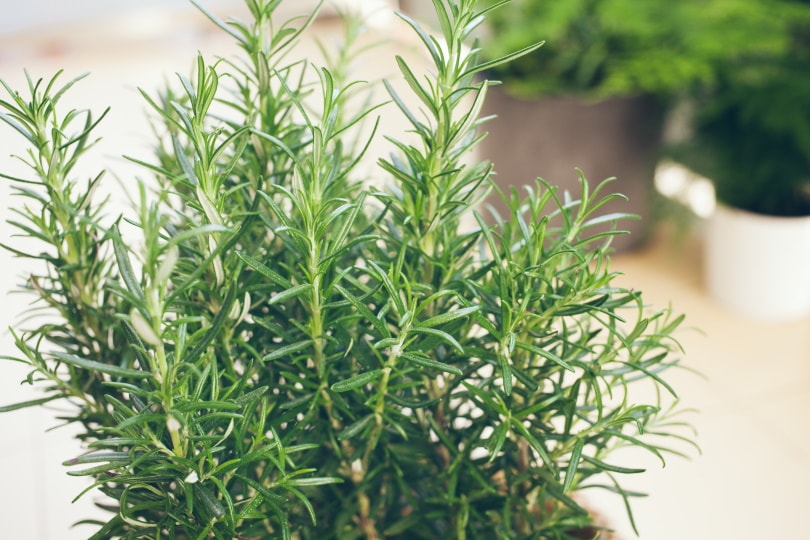
| Best Soil Type: | Well-drained loam soil |
| Soil pH: | Between 6.0 and 7.0 |
| Optimum Growing Temperature: | |
| Sunlight Exposure: | Full sun |
| Watering Requirements: | Only water for one or two weeks before it’s established |
Rosemary¹ is another herb with a strong scent that masks the celery’s scent so harmful insects don’t find it easily. This herbaceous perennial has woody stems, fragrant leaves, and small white flowers. You can use rosemary when fresh or dried as an herb for cooking.
You can plant rosemary and celery together in a sunny location with well-drained soil. Besides, you can plant them in a container if you have enough room for each one. They need to grow freely without crowding each other’s roots or stretching their branches too far for sunlight or water access.
Flower Companion Plants for Celery
9. Cosmos

| Best Soil Type: | Well-drained and not too rich in organic matter |
| Soil pH: | Between 7.0 and 7.5 (neutral to alkaline soils) |
| Optimum Growing Temperature: | Between 55°F and 60°F (13°C to 16°C) |
| Sunlight Exposure: | Full sun (eight hours a day) |
| Watering Requirements: | Frequent watering when young and moderate watering when established |
Cosmos¹ are a beautiful addition to the garden and an ideal companion for celery. They grow best in full sun, so they’re great for planting near your celery plants to give them extra protection from the sun.
Cosmos also attracts pollinators that help pollinate your celery in the garden. The plant grows in clumps, and you can use it as a border or ground cover plant.
The blooms are edible, too! The flowers are great for cutting and adding to salads. They also make a colorful addition to teas and lemonade.
10. Geranium
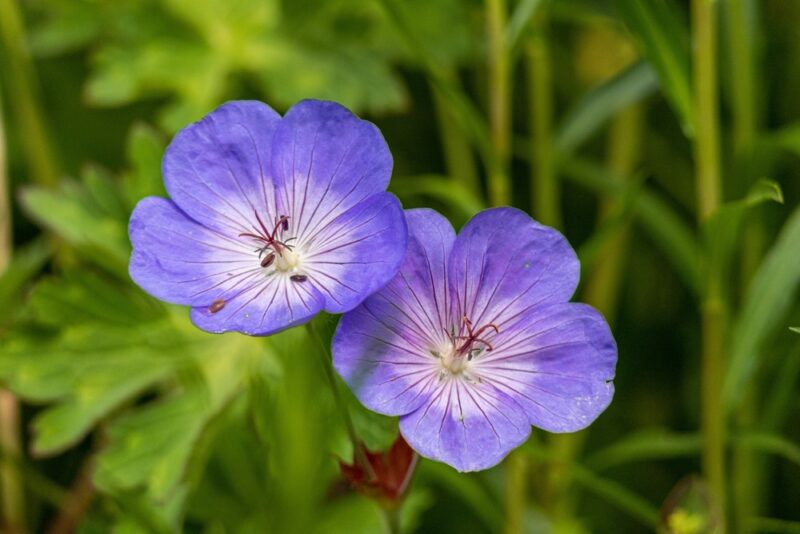
| Best Soil Type: | Loose soil high in organic matter |
| Soil pH: | Between 6.0 and 6.5 |
| Optimum Growing Temperature: | Between 70°F and 75°F during the day (21°C to 24°C) and between 60°F and 65°F during the night (15.5°C to 18°C) |
| Sunlight Exposure: | Full sun |
| Watering Requirements: | Only water when one inch of the top soil is dry |
Geranium¹ is a genus of 422 species of flowering plants in the family Geraniaceae. It’s the largest genus of the family, grown for its brightly colored flowers and attractive foliage. The most common geranium has a flat flower head with five petals. It’s often grown as an ornamental plant or as cut flowers for bouquets and arrangements.
Geraniums are one of the best companion plants for celery. They give off a strong essence that deters slugs, flea beetles, and worms that destroy celery plants. Besides these pests, the scent also repels Japanese beetles.
When geraniums mature, their flowers attract beneficial pollinators to the garden while making your garden appear attractive. You can plant geraniums in rows inside the garden.
Legume Companion Plants for Celery
11. Beans
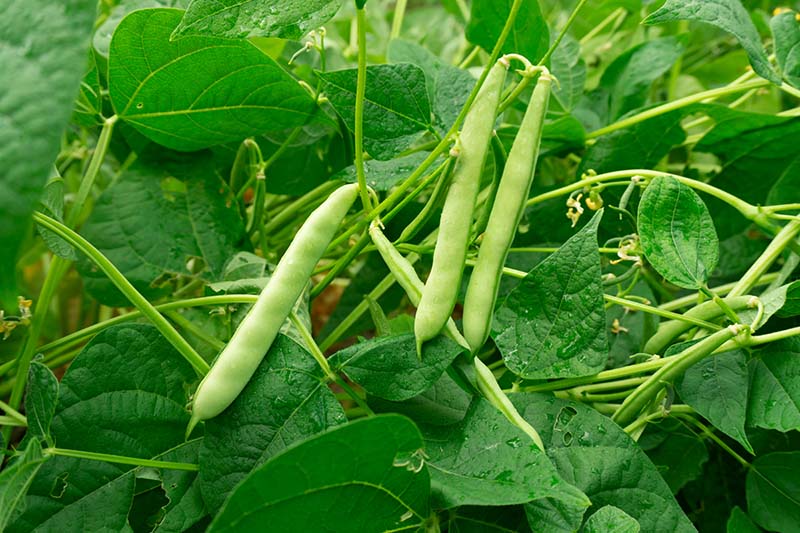
| Best Soil Type: | Well-draining, sandy or loamy soil |
| Soil pH: | Between 6.0 and 7.0 |
| Optimum Growing Temperature: | 65°F to 85°F (18°C to 29°C) |
| Sunlight Exposure: | Medium or full sun |
| Watering Requirements: | Beans growing in loamy soil don’t need watering. On the other hand, beans growing in sandy soil need an inch of rainfall every week |
Beans¹ are a great companion plant for celery. They help to fix nitrogen in the soil. Celery needs this nitrogen to thrive well as they’re heavy feeders. Planting beans on the northern side of your celery garden shades celery during hot summer days. That’s when celery needs extra protection from intense sunlight.
You can plant any bean species, but the most popular is the bush bean. You can also try pole beans for a different taste and texture. Beans are easy to grow and don’t require much maintenance.
Celery, in return, deters bean beetles that attack pole and bush beans.

Worst Companion Plants for Celery
So, now you know what plants you can plant with celery in your garden. Let’s now look at several plants you should keep off your celery garden.
- Carrots: Carrots and celery have a few pests in common, including aphids, flea beetles, and root maggots. The plants are easy to grow separately and don’t need much attention. Another thing that makes carrots unfit to grow with celery is the carrots’ tap roots. When uprooting them, you may disrupt the roots of celery.
- Corn: Corn¹ grows tall and takes up a lot of space. It will also compete with celery for nutrients and moisture.
- Parsley: It’s an excellent herb to add flavor to your meals, but it’s not suitable as a companion plant for celery because it attracts aphids that feed on celery leaves.
- Potatoes: They’re not only harmful to celery but can also be bad for your entire garden. The two plants have similar growing conditions. So, they compete with each other for nutrients and water. When digging up the potatoes, you may also uproot your celery.
- Turnips: Turnips are root vegetables grown for their edible roots. They’re related to the cabbage and mustard family. It’s not advisable to plant turnips with celery because you may disrupt the roots of celery when harvesting turnips.
Conclusion
Companion planting is an excellent way to increase yields and keep pests away from your crops. It also works in making your plants more resistant to stressful conditions.
Companion plants should do well in the same location as celery, but you might want to consider whether they’ll help or hinder your tiny crop. Some can attract pests, others might compete for nutrients, and some will spread where you don’t want them to.
Experiment to see what works best for you, but keep this list handy the next time you plant celery.
- Related Read: 14 Companion Plants For Turnips (With Pictures)
Featured Image Credit: adrian2019, Pixabay
Contents

